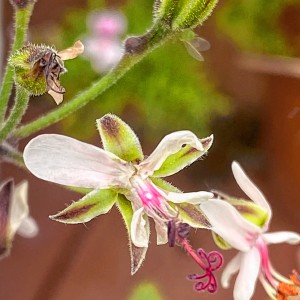The essence of herbs: Aromatic and versatile, they enhance most any dish
| Published: 06-09-2017 4:20 PM |
Though herbs look modest sitting on supermarket shelves or waving from their corner of the garden, their aromas promise power and magic. They certainly cast lovely spells on food, brightening its flavors, and pairing up in happy marriages such as basil and tomatoes, dill and cucumbers, mint and lamb.
Now, as summer nears, local herbs abound. Clumps of chives and mint have been growing since the ground thawed. Thyme, sage, cilantro, oregano and dill are with us, too, and so is basil.
It’s worth squirreling away some herbs for winter. Freezing is easy. Pick the herbs when they are at their best, rinse them clean, then chop. Next, half fill each cup of an ice-cube tray with them, pour on boiling water, let cool, then freeze. This works well for basil, chives, dill, parsley and most mints.
When it’s time to use them, you can drop the cubes into soups and stews to zing them with summer flavor.
Drying herbs by hanging bunches in an airy spot is an old-timey way to preserve them. You can also dry them in a microwave. Simply place them on a paper towel and zap them in 20 or 30 second bursts. Timing depends on the moisture in the leaves, and the power of the microwave. Woody herbs such as rosemary and thyme take about 30 to 50 seconds, while soft-leaf herbs, such as mint, may take 3 minutes. Sealed in containers and stored in a darkened place, microwave-dried herbs hold their color and fragrances well. Use them in sauces, marinades and herbal teas.
Mint, rosemary, thyme, sage, tarragon, dill and some other herbs dry well. Basil, cilantro, parsley and chives lose their flavor, but you can capture it in butter. Wash, dry and finely chop the herb, then mix into room temperature butter. Pack it in containers, or form into sticks, Covered or wrapped in plastic, herb butters keep for two to three weeks in the fridge, and at least two months in the freezer. Use the butter for sautéing, topping vegetables or stirring into pasta or rice.
The classic French maître d’hôtel butter is made with parsley and a little lemon juice. Other good combinations include parsley with chives or tarragon or both, and oregano and thyme with garlic.
Oil and vinegar also can preserve herb flavors. Pack jars tightly with one herb or a variety, add either mildly flavored oil such as sunflower or canola, or warmed cider or white-wine vinegar. Cover and set in a sunny window. Shake every day for a couple of weeks. For a stronger flavor, replace the herbs with fresh ones and repeat the process. Bottle (using non-corrosive caps for vinegars), and add a herb stem for eye-appeal.
Article continues after...
Yesterday's Most Read Articles
 South Hadley man fatally shot in attempted robbery
South Hadley man fatally shot in attempted robbery
 Smith College exhibit explores Sylvia Plath’s botanical inspiration
Smith College exhibit explores Sylvia Plath’s botanical inspiration
 Holyoke man finds bear paw in his yard
Holyoke man finds bear paw in his yard
 Guest columnist Bill Dwight: How to make sense of Northampton’s school budget dilemma
Guest columnist Bill Dwight: How to make sense of Northampton’s school budget dilemma
 South Hadley’s Lauren Marjanski signs National Letter of Intent to play soccer at Siena College
South Hadley’s Lauren Marjanski signs National Letter of Intent to play soccer at Siena College
 Deerfield residents petitioning to fix ‘dangerous’ intersection
Deerfield residents petitioning to fix ‘dangerous’ intersection
Tarragon, dill and chives, including their blossoms, are especially good in vinegar. Basil, garlic and rosemary are good in oil. Herbal oils are good for frying and both oils and vinegars add flavor to marinades and salad dressings.
Pesto is based on basil and olive oil. You can get a head start by chopping the basil and mixing it with oil then freezing it. When you need it, defrost it and add the other ingredients. Similarly, you can chop mint and make it into a paste with vinegar, so when you need mint sauce to serve with lamb you need only add a little sugar, salt and water.
Your foresight will reap a rich reward when you use your herbs in winter. Right now their aromas wafting around your kitchen as you chop and pack them away will whet your appetite for immediate pleasures. Here are some recipes for summery dishes in which herbs work their magic charms.
Many cultures give basil a special role. For Greeks it is the herb of kingship. They don’t eat it but they keep pots by their doors for good fortune. Haitians hold it sacred to Erzulie, the voodoo Venus, while Hindus link it to Vishnu, a supreme god and protector.
The flavor is intense and almost addictive. In these toasts it’s backed up with other herbs. The toasts help make a meal of salads and soups, and make vigorous partners to meat dishes and cookout foods.
1 tablespoon all-purpose flour
5 tablespoons butter at room temperature
1 egg, beaten
About 1 tablespoon snipped basil
1 tablespoon finely snipped chives
2 teaspoons chopped parsley
1 teaspoon fresh thyme leaves
About ¼ teaspoon salt plus pepper to taste
About 6-8 medium-large slices tasty bread such as baguette or Italian bread or halved rolls
2 tablespoons pine nuts
Preheat the oven to 350 degrees and lightly grease a baking sheet or line it with parchment.
In a bowl work the flour into the butter then stir in the egg to form a thick paste. When blended, add the basil, chives, parsley and thyme plus salt and pepper to taste.
Spread this mixture on the slices of bread or rolls. Place on the prepared cookie sheet and bake in the center of the oven for 12-15 minutes or until the topping and nuts are golden.
Zucchini and summer squash are close cousins and either can be used in this recipe. Zucchini grows quickly. Use small ones — between 3 and 5 inches — to make this light summery soup.
4 cups chicken or vegetable stock
Salt to taste
1 onion, chopped
6 peppercorns
3 stems fresh thyme
1 teaspoon chopped fresh sage
1 cup cooked chicken cut in ½-inch pieces
1 pound zucchini (about 4 zucchinis 5-6 inches each), grated
1 tablespoon chopped fresh parsley
Put the stock in a saucepan, season lightly with salt and add the onion, peppercorns and thyme. Simmer for 7-8 minutes or until the onion is tender.
Now add the sage and chicken and simmer for another 5 minutes. Add the grated zucchini — you should have about 6 cups — and simmer for just 2 minutes more. Serve immediately, garnished with the chopped parsley.
This pretty salad uses June’s local strawberries and seasonal flowers. While many flowers are edible, be sure to use your own garden flowers or wild flowers that have not been treated with chemical pesticides and fungicides.
4-6 cups young spinach leaves or a mixture of spinach and arugula, washed and dried
4 sprigs curly parsley
3 stems thyme (include flowery stems if you have them)
2 stems cilantro
2 basil leaves plus a sprig for garnish
1 tablespoon finely snipped chives plus chive blossoms if available
1 dozen ripe strawberries, halved
1 dozen slices cucumber
1-2 tablespoons olive oil
Salt to taste
Half a lemon
Edible flowers or petals such as calendula, heartsease, violets, roses, nasturtiums or the flowers of bolted bok choy, arugula, or broccoli, or of herbs such as thyme and rosemary
Put the washed and dried leaves in a salad bowl. Wash and dry all the herbs. Coarsely chop about two thirds of the parsley and add to the leaves. Also add the thyme leaves stripped from the stems, most of the cilantro leaves, the torn basil leaves, and the snipped chives. Toss to mix.
Add most of the strawberries and cucumber slices. Just before serving, toss in olive oil, season lightly with salt, and squeeze a little lemon juice on top. Add the remaining strawberries, the reserved parsley and cilantro, a basil sprig or two, and the flowers from the herbs or your choice from the list above.
Chimichurri is an herb sauce that’s vital to Argentinian cooking, and in various forms popular also in other South American countries.
The ingredients vary, but parsley, an array of other herbs, and oil and vinegar are constants. Though small amounts of hot peppers may be added, chimichurri is not a spicy-hot condiment like Mexican salsas, so don’t use too much. In Argentina it’s used as a marinade or relish with beef, pork and lamb, and also appears on sandwiches such a this favorite. Any kind of flavorful sausage can be used.
For the chimichurri:
1 clove garlic
½ cup finely chopped parsley
1 tablespoon dried thyme
2 teaspoons dried marjoram or oregano
½ teaspoon powdered cumin
1 scallion finely chopped (or more to taste)
½ red pepper or 1 small red and 1 small yellow pepper
½ cup olive oil
¼ cup white vinegar or more to taste
Salt to taste
Pinch red pepper flakes to taste or ½ teaspoon chili powder
1 bay leaf
Everything should be finely chopped, yet each ingredient should be identifiable. So chop everything, being especially sure to chop the peppers into teeny tiny dice.
Put the olive oil and vinegar in a jar and add all the chopped ingredients plus the salt, red pepper flakes and bay leaf. Add half a cup of warm water; put on the lid and shake. Leave for 12 hours (or longer if more convenient), shaking from time to time.
For the choripan:
2 onions, peeled, quartered and thinly sliced
4 tablespoons oil
1 baguette
1 teaspoon dried oregano
4 Italian sausages or bratwurst or kielbasa — about 1 pound
Having cut the onions very thinly, put them in a frying pan with 2 tablespoons of oil and fry gently until they become golden and very tender. Set aside.
Preheat the oven to 350 degrees. Cut the baguette into slices. Mix the remaining 2 tablespoons of the olive oil plus any oil left in the onion pan with the oregano and brush each slice with a little. Wrap the slices in foil and put them in the oven to warm while you fry the sausages, first cutting them in thick slices.
For serving, top a bread slice with a little onion and a couple of sausage slices. Spoon chimichurri on top.
This pear salad is a cool but vibrant choice for summer.
1 navel orange
1 Earl Grey or Lady Grey tea bag or an herbal tea-bag
⅔ cup sugar
6 Anjou pears, peeled, cored and sliced into 8-10 sections
1 teaspoon snipped lemon balm plus one leaf
1 teaspoon cornstarch
2 teaspoons snipped mint plus sprigs
Using a swivel-bladed vegetables peel, peel 4 strips, each 2 inches, from the orange, making sure you get just the orange part not the white pith. Put them in a saucepan along with 2 cups water and the sugar.
Squeeze the orange and add 4 tablespoons of its juice to the pan. Stir over the heat until the sugar has dissolved then add the tea bag.
Stir again and add the pears. Cook until tender, which depends on how ripe they are but from 5 to 25 minutes. Test for tenderness while they are cooking. When they are ready, mix the cornstarch with a couple of teaspoons of cold water. Add a tablespoon or so of the pan liquid to the cornstarch, then stir the cornstarch mix gently into the pears.
As soon as the pan liquid has thickened take the pan from the heat, Discard the orange peel strips, the lemon balm leaf and the tea bag. Stir in the snipped lemon balm and mint. Let cool, then chill. Serve with mint sprigs for garnish.
]]>

 Valley Bounty: Grass-fed animals that feed the grass: Gwydyr Farm in Southampton focuses on ‘restoring the connection between land, food and people’
Valley Bounty: Grass-fed animals that feed the grass: Gwydyr Farm in Southampton focuses on ‘restoring the connection between land, food and people’ Weekly Food Photo Contest: This week’s winner: Mary Chicoine of Easthampton
Weekly Food Photo Contest: This week’s winner: Mary Chicoine of Easthampton  Speaking of Nature: A romantic evening for two birders — To hear the wonderful sounds of the Saw-whet Owl one must go outside at night
Speaking of Nature: A romantic evening for two birders — To hear the wonderful sounds of the Saw-whet Owl one must go outside at night Speaking of Nature: Where have all the birds gone?: They’re there, and here’s a handy tool to keep track of their appearances
Speaking of Nature: Where have all the birds gone?: They’re there, and here’s a handy tool to keep track of their appearances
